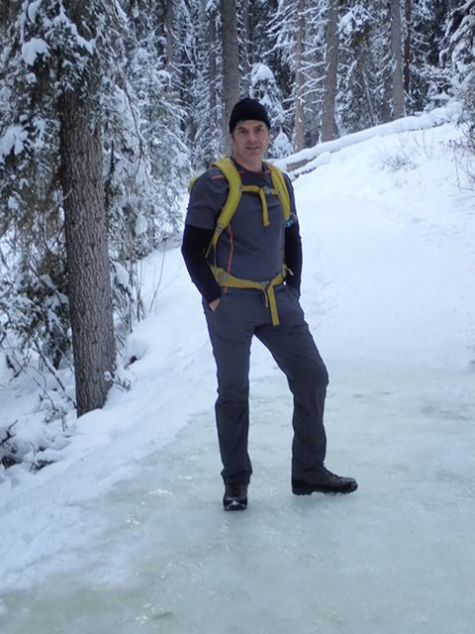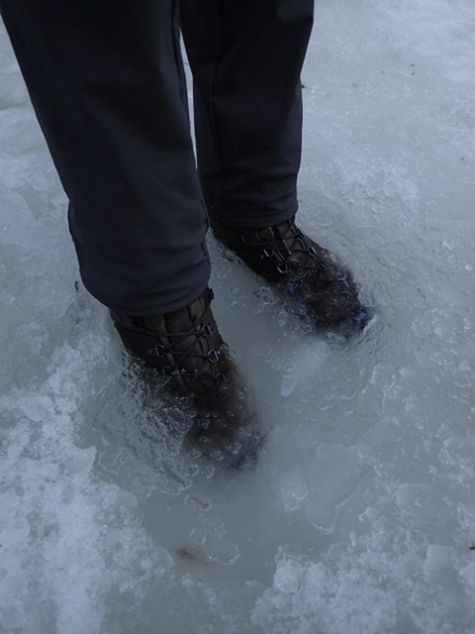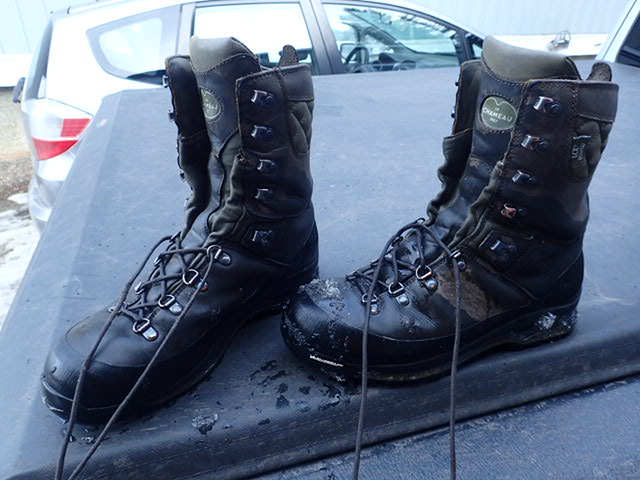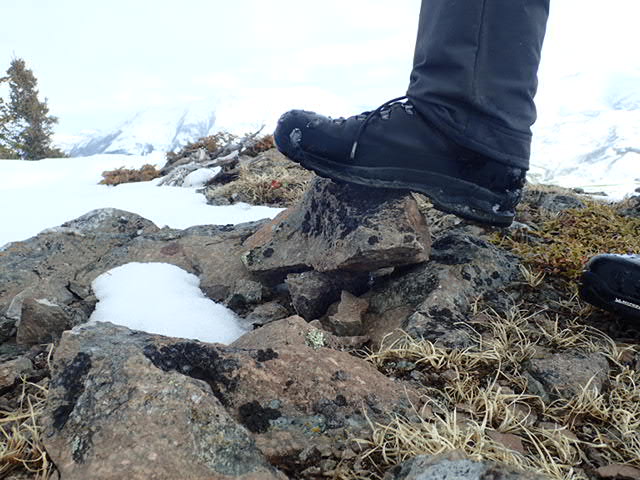Tester Information
Name: Duane
Lawrence
Email: duanesgear
(at) yahoo (dot) com
Location:
Sparwood, British Columbia Canada
Gender: Male
Age: 45 years
Height:
5’9” (1.75 m)
Weight:
160 lbs (73 kg)
Shoe Size: 9.5
I have been an avid outdoor enthusiast for over 25
years. I enjoy a variety of outdoor activities including mountaineering,
day hikes, multi-day backpacking trips, river and ocean kayaking, back-country
skiing, snowshoeing, mountain biking and rock climbing. I have climbed
throughout British Columbia, the United States and when opportunity presents
itself in Europe and India. I carry a wide variety of gear depending on the
type and length of trip. I am a search and rescue team member in the
Southern Canadian Rockies and am part of the swift water, rope rescue and
avalanche technical teams and ground search team.

| Manufacturer | La Chameau | | Model | Condor LCX Hunting Boot | | MSRP | $399 USD | | Web Site | www.lechameau.com | | Listed Weight | 1490 g (3.28 lb) pair
| | Measured Weight | 1592 g (3.51 lb)
| | Sizes | US 6 - 13 | | Colors | Marron
| | Suggested Use | Game Stalking | | Warranty | 2-year material and workmanship |

Technical
Details
The
Le
Chameau LCX Hunting boot is made of a 2.2 mm (.87 in) oiled Nubuck
Leather with a 2.5 cm (1 in)
rand, measured at the side of the boot, and soft leather at
the back and
in the upper of the boot which looks to provide added flexibility.
The
upper is 25 cm (9.8 in) tall, measured from the sole of the boot.
The sole of the
boot uses a Michelin Deep Forest rubber which uses motocross tire
technology reportedly creating an exceptionally light,
hard-wearing and comfortable
outsole which is flexible while still allowing the rubber to grip in
demanding
terrain. The sole includes flexion lines that prevent fatigue on
long
walks, abrasion resistance, lateral stability and an all-terrain
traction and
grip on obstacles.
The boots are constructed using a 5-layer technology with a LCX lining which is designed
to prevent water permeating the boot while allowing moisture to easily escape.
The layering system consists of an external material, protective film,
inner membrane, a functional non-woven material and inside lining. The
boot is rated as a 100% waterproof boot that will keep feet warm down to -10
C (14 F). Interestingly there is nowhere on the web site or in the box that that indicated that
the leather needs to be treated at all. It will be very interesting to
find out how waterproof these boots are over a period of days in wet weather.
If it is indeed the case that the boots do not need to be treated I will
be very impressed and happy not to have to treat them on a regular basis.
Sizing
Sizing
for these boots should have been fairly straight forward, unfortunately I dug a
little too deep into the web site and sized my boots off the 'boot' sizing
chart rather than the one listed on the Condor LCX Hunting Boot page. I would
normally think that there would not be any difference between the two but there
actually is. The sizing chart for 'Boots' reads a size US Men's 9, 10 and
11 (no size 9.5) as EU 42, EU 43 and EU 44 respectively while the
sizing chart on the Hunting boot page lists the sizes EU 43 as a
US MEN 9.5 and EU 44 as a US MEN 10. I found this a little
confusing and ended up with the wrong sized boots which I am going to have to
exchange. The good news is the supplier was very quick to reply to my
request for a new size, same day actually, so I am optimis tic that I will be
able to resolve the sizing issue fairly quickly. tic that I will be
able to resolve the sizing issue fairly quickly.
Care
The web site has a very clear care guide, it was nice not to have to sift through much
to find out how to take care of these boots. The web site divides it into
Do's and Don'ts. Recommend care includes clearing them with water and a
brush and let air dry. A silicone spray with a soft dry cloth for
polishing is also recommend for treating any rubber. They recommend keeping them in a dry
ventilated place away from direct sunlight and if the boots get wet to dry the
liner out. They make the suggestion to use crumpled newspaper stuffed
into the boot to help dry them. Lastly they recommend to clean them
before storing for long periods of time. For the Don’ts they advise not
to dry the boots with a direct heat source like a fire or radiator, not to use
detergents nor to store boots in damp conditions or folded.
Initial Observations

These are a very nice looking boot. They are made of a full grain leather
with softer leather at key flex points which look like they will allow easy
flexing of the ankle and no binding of the tongue fabric. I have never
had a pair of boots with a 25 cm (9.8 in) ankle rise but although they were a little
big when I tried them on they were very comfortable. The high ankle
will undoubtedly keep forest debris and snow from entering the boot. There is
nothing really special about the insole, just a basic insole but it does
appear that there is room for a replacement insole if needed. The boots are also incredibly
light. I was very surprised when I picked them up as I just did not
expect a hefty looking boot to weigh so little only 1592 g (3.51 lb) for the
pair. The sole of the boot looks durable and the 2.5 cm (1 in) rand that runs
around the entirety of the boot should protect the leather and increase its
weather resistance. For construction the boots look solid with single, double
and triple stitching throughout. The lacing uses steel grommets and
hooks which will provide lots of options for tightening the boot and allowing
for lots of micro adjustments. Inside the boot is a soft fabric liner
which is quite thick. I tried to measure it but do not have a caliper
tool to provide anything with accuracy. Overall they look like a very nice boot
that I am hoping will be great for the winter weather we have up in the
Canadian Rockies.
Filed Report - February 16, 2018 Although the testing for these boots started off a little
slow due to a sizing issue over the last five weeks or so I was able to get a
good feel for how the boots hold up in cold to very cold temperatures as well
as in the snow. Aside from using them during my regular search and rescue
training days I headed out on four snowshoeing day hikes in and round Banff and
a snowmobile trip in the Elk Valley. The snowshoe trips ranged from 5 km
to 20 km (3 mi to 12.4 mi) with a maximum elevation gain of about 600 m (2000 ft) with a total distance
accumulation of 38 km (23.6 mi). Temperatures ranged from a balmy -4 C (24 F) to a
slightly frigid temperature of -25 C (-13 F). As the reader may have guessed
already trail conditions involved snow and more snow. During my
snowmobile trip I was out in -15 C to -25 C ( 5 F to -13 F) for about 14 hours which gave a
good indication of temperature comfort levels.
    Before I was able to get out in the snow I did have to get a new pair sent out
as they were just a little too big. The downside of not trying them on
before purchasing them. Once I did receive the new size I still ended up
swapping out the insoles with a beefier pair of insoles. I found that the
thin insoles that came with the boots were a little thin for me and I needed to
reduce the amount of volume within the boot. This is not unusual for me
so I would not hold this against the boot manufacture. Once I put the
thicker insole in I was very pleased with the fit. I did find that it
took a little bit to get used to the high upper. It was a little strange
having the upper of the boot come up so high on my calf but it was not a big
deal and after only a couple of hikes I was used to the design. Lacing of
the boot is ve ry versatile with locking eyelets midway up the boot. I was
having a heck of a time getting them to let loose when I wanted to take the
boots off but I believe this is operator issue and not design since it is an
intermittent challenge. I should note that I did bend one of the eyelets
(see photo). I am not sure how I managed this but suspect that I caught it on a
rail of the sled. Since I noticed I bent it back with a pair of pliers
with no apparent detriment to the lacing system. ry versatile with locking eyelets midway up the boot. I was
having a heck of a time getting them to let loose when I wanted to take the
boots off but I believe this is operator issue and not design since it is an
intermittent challenge. I should note that I did bend one of the eyelets
(see photo). I am not sure how I managed this but suspect that I caught it on a
rail of the sled. Since I noticed I bent it back with a pair of pliers
with no apparent detriment to the lacing system.
Thus far the boots are holding up very well with no
discernible wear to neither the rubber, sole nor leather components. They
also doing incredibly well in the snow with no evidence of water penetration.
 While hiking I came across a convenient puddle filled with ice and took
the opportunity to see how the boots would both stand up to being submerged in
water as well as how well they would deal with ice water. I ended up
standing in the puddle for about 3 or 4 minutes before I got bored and the
boots did awesome. Aside from my feet staying nice and warm there was no
water penetration into the leather. The water beaded off the boot as soon
as I exited the puddle. Ice did form on the boots as soon as I got back
to hiking but shed this fairly quickly. While on my 20 km (12.4 mi)
snowshoe there was also no evidence of water penetration. I would like to note
that the high upper was incredibly effective in keeping snow out of the top of
the boot. It snugs up again my calf really well and even when plunging
through hip deep snow with no gaiters I did not get any snow in the boot.
During one of my excursions I also came across a nice patch of ice to
play on and during all of my trips I had opportunities to see how the outsole
gripped. Overall I was quite pleased with their ability to grip ice and
snow. They were able to dig in and grip varying degrees of compacted snow
and ice. They also did a great job of shedding snow from the rubber
cleats of the outsole which no apparent buildup of snow on the bottom of the
boot. While hiking I came across a convenient puddle filled with ice and took
the opportunity to see how the boots would both stand up to being submerged in
water as well as how well they would deal with ice water. I ended up
standing in the puddle for about 3 or 4 minutes before I got bored and the
boots did awesome. Aside from my feet staying nice and warm there was no
water penetration into the leather. The water beaded off the boot as soon
as I exited the puddle. Ice did form on the boots as soon as I got back
to hiking but shed this fairly quickly. While on my 20 km (12.4 mi)
snowshoe there was also no evidence of water penetration. I would like to note
that the high upper was incredibly effective in keeping snow out of the top of
the boot. It snugs up again my calf really well and even when plunging
through hip deep snow with no gaiters I did not get any snow in the boot.
During one of my excursions I also came across a nice patch of ice to
play on and during all of my trips I had opportunities to see how the outsole
gripped. Overall I was quite pleased with their ability to grip ice and
snow. They were able to dig in and grip varying degrees of compacted snow
and ice. They also did a great job of shedding snow from the rubber
cleats of the outsole which no apparent buildup of snow on the bottom of the
boot. For warmth, these boots are rated for -10 C (14 F) and I can attest that I had no
issues up to about -20 C (-4 F). On my sledding trip the temperatures did get
down to -25 C (-13 F) and my feet were starting to get a little cold but only when I
stopped moving. Normally I would prefer something a little warmer in
those extreme cold conditions but the boots did remarkably well. I should
note that I did have my heaviest wool socks on but I would have had those on
regardless.
With respect to fit and comfort, I am very pleased with the boots so far.
Aside from getting used to the high uppers the boots are very comfortable.
I have experienced no blistering or hot spots and did not 'break them in'
prior to using them. The significant amount of lacing provides lots of room
to make adjustments either on top of the foot, around the ankle and to the
upper. I haven't done much with a heavy pack yet, need to find an opportunity
later in the test period when the snow melts to see how they hold up with a
heavier backpacking load and on a dirt trail, but in the snow they have done
very well.
Long Term Report - April 21, 2018
It's well into April and supposedly spring, although the snow is still deep and
falling from the sky so the last two months of the test period involved lots of
snowshoeing and hiking with strap on boot cleats for walking on ice. Over
all I was able to put on another 100 km (62 mi) or so of hiking with an additional 30
days or so of just wearing them around town and to and from work. My longest
snowshoe trip was for 16 km (10 mi) with an elevation gain of 300 m (984 ft) or so with the
remainder of my hikes in the 10 km to 12 km (6.2 to 7.5 mi) range. I would have really
like to take them out on a dirt trail but it just wasn't in the cards with
several feet of snow still on the ground. Temperatures were warmed up a
bit with ranging from -10 C (14 F) all the way up to plus 6 C (43 F). Snow conditions
were a mix of dry powder, wet heavy snow and snow turning to slush. There
was also lots and lots of ice to walk on.
 The one good thing about melting snow is that it really does allow for the
testing of how waterproof the boots are under adverse conditions. I am
still a little surprised that treating of the leather was not required but the
for the most part the boots stood up very well to slush. That is until they
reach a point where they didn't. This only occurred during my longer
snowshoe trips and through snow turning to slush. The constant melting
snow on the boots overwhelmed the waterproofing especially where there was
contact between the boot and the snowshoe. I noticed it towards the end
of the hikes and did end up with soggy feet. Regardless if it is
recommended or not I'll be treating the boots with some form of leather
treatment to both keep the leather in good shape plus add more water resistance
to them.
The one good thing about melting snow is that it really does allow for the
testing of how waterproof the boots are under adverse conditions. I am
still a little surprised that treating of the leather was not required but the
for the most part the boots stood up very well to slush. That is until they
reach a point where they didn't. This only occurred during my longer
snowshoe trips and through snow turning to slush. The constant melting
snow on the boots overwhelmed the waterproofing especially where there was
contact between the boot and the snowshoe. I noticed it towards the end
of the hikes and did end up with soggy feet. Regardless if it is
recommended or not I'll be treating the boots with some form of leather
treatment to both keep the leather in good shape plus add more water resistance
to them.
For wear and tear the boots are in excellent shape. I actually do not
have much to say other than they look great, no wear points the rubber rand did
not degrade or wear in any way and the sole is looking like new. I would
note that this could be due, in part, to only wearing them in the snow.
There was very little opportunity to this winter to really test out the
durability of the boot when hiking on dirt rocks and scree.
My only complaint with
these boots is the locking hook eyelets that hold the lacing in place dividing
the upper from the rest of the boot. The laces locked into the eyelets so
effectively that whenever I wanted to take them off I had a fight on my hands
trying to get the right angle and use substantial force to unlock the lace from
the hook eyelet. This was compounded as the locking hook eyelet is on a
floating piece of leather that is really flexible making that much more
difficult to undo the laces.
 Looking at their warmth level I did notice a marked change in comfort as the
temperatures warmed up. The Condor LCX boot is a very warm boot resulting
is my feet starting to sweat as soon as the temperatures moved up above 0 C (32
F). I was quite happy with the warmth they provided when it was cold out
but as soon as it warmed up a bit the insulation in the boot caused sweating
and even resulted in a blister under my big toe. Admittedly this was a
first for me in a strange location but I can only chalk it up to sweaty feet
and failing to tighten up the lacing when I started back down the trail.
The moisture and the downward rub resulted in the blister forming within
2 km of hiking. I would like to note that this is the only instance of a
blister forming and throughout the remainder of the test the boots were very
comfortable with no real break in time.
Looking at their warmth level I did notice a marked change in comfort as the
temperatures warmed up. The Condor LCX boot is a very warm boot resulting
is my feet starting to sweat as soon as the temperatures moved up above 0 C (32
F). I was quite happy with the warmth they provided when it was cold out
but as soon as it warmed up a bit the insulation in the boot caused sweating
and even resulted in a blister under my big toe. Admittedly this was a
first for me in a strange location but I can only chalk it up to sweaty feet
and failing to tighten up the lacing when I started back down the trail.
The moisture and the downward rub resulted in the blister forming within
2 km of hiking. I would like to note that this is the only instance of a
blister forming and throughout the remainder of the test the boots were very
comfortable with no real break in time.
The last item I can think to comment on is the tall upper. I am still not
sure if I am a fan or not of the 25 cm (9.8 in) upper. The down side is
only with respect to comfort and getting used to having the upper of the boot
laced high up the calf. I got used to it but I am not 100% sure I like it
or not. One the plus side is that the tall uppers keep everything out of
the boot and give great ankle support. I decided not to wear gaiters
while testing the boots to see how effective the tall upper would manage
keeping out snow and woody debris out of the boot. I personally dislike gaiters
so it was really nice to find that nothing managed to make its way up to the
top of the boot and then in. Granted I was dealing with snow but I am
fairly confident that I can extend this observation to most trail debris.
Summary
Overall I would say that these are a very nice pair of winter boots. The
tall upper, although I found that it took a bit to get used to, was very
supportive and kept snow out of the boot while providing excellent ankle
support. The generous rubber rand around the boot appeared to help keep
moisture at bay. The leather shows no sign of wear although it is going
to require treating in order to maintain its initial waterproofness. The
sole was good on snow and ice and the overall warmth of the boot was excellent
providing ample warmth down to -20 C (-4 F). The boots were a little roomy for
me and I did replace the very flimsy insole with a much more substantial
one which made a big difference. My only complaint was with the locking
hook eyelets where true to their name locked the laces in place incredibly
well. I just wish they would allow the laces to be unlocked a little
easier. I anticipate that I will be happily using these boots for many
years in the late fall and throughout the winter. On the whole the Le
Chameau Condor LCX Hunting boot is a very nice high quality boot.
Thank you to BackpackGearTest.org and Le Chameau for the opportunity to
test the Condor LCX Hunting Boots.
Read more reviews of Le Chameau gear
Read more gear reviews by Duane Lawrence
|






